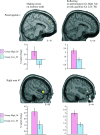Motivation to do well enhances responses to errors and self-monitoring
- PMID: 18660499
- PMCID: PMC2651478
- DOI: 10.1093/cercor/bhn127
Motivation to do well enhances responses to errors and self-monitoring
Abstract
Humans are unique in being able to reflect on their own performance. For example, we are more motivated to do well on a task when we are told that our abilities are being evaluated. We set out to study the effect of self-motivation on a working memory task. By telling one group of participants that we were assessing their cognitive abilities, and another group that we were simply optimizing task parameters, we managed to enhance the motivation to do well in the first group. We matched the performance between the groups. During functional magnetic resonance imaging, the motivated group showed enhanced activity when making errors. This activity was extensive, including the anterior paracingulate cortex, lateral prefrontal and orbitofrontal cortex. These areas showed enhanced interaction with each other. The anterior paracingulate activity correlated with self-image ratings, and overlapped with activity when participants explicitly reflected upon their performance. We suggest that the motivation to do well leads to treating errors as being in conflict with one's ideals for oneself.
Figures





References
-
- Amodio DM, Frith CD. Meeting of minds: the medial frontal cortex and social cognition. Nat Rev Neurosci. 2006;7:268–277. - PubMed
-
- Bandura A. Self-regulation of motivation and action through internal standards and goal systems. In: Pervin LA, editor. Goal concepts in personality and social psychology. Hillsdale (NJ): Erlbaum; 1989. pp. 19–85.
-
- Braver TS, Cohen JD, Nystrom LE, Jonides J, Smith EE, Noll DC. A parametric study of prefrontal cortex involvement in human working memory. Neuroimage. 1997;5:49–62. - PubMed
-
- Burns D. Feeling good. New York: HarperCollins; 2007.

